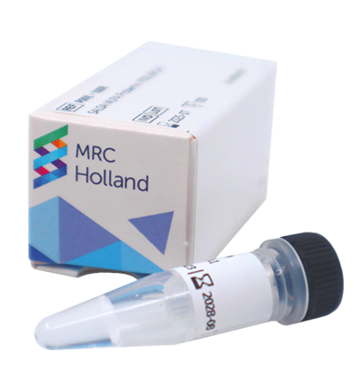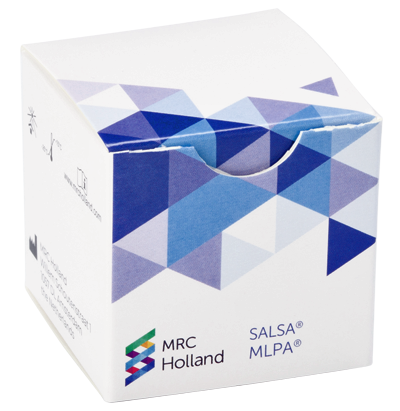The SALSA MLPA Probemix P370 BRAF-IDH1-IDH2 is a research use only (RUO) assay for detection of the BRAF p.V600E & four predominant IDH1 (p.R132H and p.R132C) and IDH2 (p.R172M and p.R172K) point mutations, for detection of genomic duplications leading to the SRGAP3-RAF1, KIAA1549-BRAF and FGFR1-TACC1 fusion genes on chromosome arms 3p, 7q and 8p respectively, and for detection of copy number aberrations in the BRAF, CDKN2A/2B, FGFR1, MYB and MYBL1 genes.
The IDH1 and IDH2 mutations represent frequent genetic abnormalities in gliomas. Their identification facilitates distinguishing the different glioma entities leading to a more accurate prognosis and treatment (Riemenschneider et al. 2010). IDH1 and IDH2 point mutations have been detected with high frequency in diffuse gliomas (Hartmann et al. 2009; Yan et al. 2009), and the presence of these mutations is associated with a longer survival (Sanson et al. 2009; van den Bent et al. 2010). IDH1/2 mutation is a marker for glioma classification since 2016, defining glioblastomas as IDH-mutant or IDH-wildtype (Wesseling and Capper 2018). This MLPA probemix contains probes that are specific for the two most frequent IDH1 (p.R132H and p.R132C) and the two most frequent IDH2 (p.R172M and p.R172K) mutations.
Activation of the MAPK pathway has been detected with high frequency in pilocytic astrocytomas, in particular via a 2 Mb tandem duplication leading to an oncogenic KIAA1549-BRAF fusion gene at 7q34 (Jones et al. 2008). Detection of this duplication is of help in differentiating these tumours from diffuse astrocytomas. Alternative MAPK pathway activation mechanisms include: 1) the formation of a similar SRGAP3-RAF1 fusion gene at 3p25, through a 3.6 Mb tandem duplication (Jones et al. 2009), 2) intragenic duplications of FGFR1 and FGFR1-TACC1 microamplifications (Zhang et al. 2013; Jones et al. 2013), and 3) certain BRAF mutations, in particular the p.V600E mutation (Schiffman et al. 2010; Dougherty et al. 2010). The BRAF p.V600E activating mutation in combination with deletion of CDKN2A was found to be significantly enriched in cases of low grade glioma that are undergoing transformation to secondary high grade gliomas (Mistry et al. 2015), suggesting to define a clinical distinct subgroup of childhood glioma.
This probemix also includes probes for the FGFR1, MYB and MYBL1 genes and for the 9p21.3 region (CDKN2A/2B, MIR31). All these genes and regions are suggested to help in differentiating molecular subtypes of gliomas (see Table 2a for more detailed information). Furthermore, this probemix contains 13 reference probes detecting autosomal chromosomal locations that are regarded as relatively stable in gliomas and brain tumours. However, it should be noticed that glioma karyotypes can harbour multiple numerical and structural aberrations, which can complicate interpretation of these reference probes.






